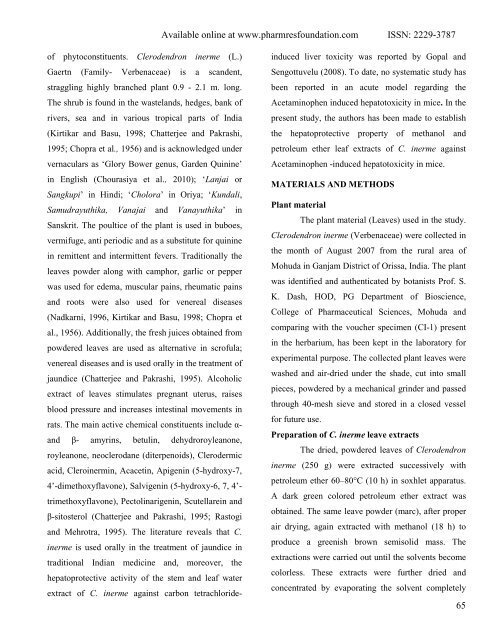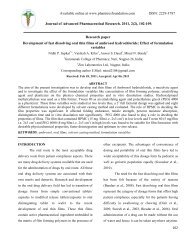Available online at www.pharmresfoundation.com ISSN: 2229-3787 ...
Available online at www.pharmresfoundation.com ISSN: 2229-3787 ...
Available online at www.pharmresfoundation.com ISSN: 2229-3787 ...
You also want an ePaper? Increase the reach of your titles
YUMPU automatically turns print PDFs into web optimized ePapers that Google loves.
of phytoconstituents. Clerodendron inerme (L.)<br />
Gaertn (Family- Verbenaceae) is a scandent,<br />
straggling highly branched plant 0.9 - 2.1 m. long.<br />
The shrub is found in the wastelands, hedges, bank of<br />
rivers, sea and in various tropical parts of India<br />
(Kirtikar and Basu, 1998; Ch<strong>at</strong>terjee and Pakrashi,<br />
1995; Chopra et al., 1956) and is acknowledged under<br />
vernaculars as ‘Glory Bower genus, Garden Quinine’<br />
in English (Chourasiya et al., 2010); ‘Lanjai or<br />
Sangkupi’ in Hindi; ‘Cholora’ in Oriya; ‘Kundali,<br />
Samudrayuthika, Vanajai and Vanayuthika’ in<br />
Sanskrit. The poultice of the plant is used in buboes,<br />
vermifuge, anti periodic and as a substitute for quinine<br />
in remittent and intermittent fevers. Traditionally the<br />
leaves powder along with camphor, garlic or pepper<br />
was used for edema, muscular pains, rheum<strong>at</strong>ic pains<br />
and roots were also used for venereal diseases<br />
(Nadkarni, 1996, Kirtikar and Basu, 1998; Chopra et<br />
al., 1956). Additionally, the fresh juices obtained from<br />
powdered leaves are used as altern<strong>at</strong>ive in scrofula;<br />
venereal diseases and is used orally in the tre<strong>at</strong>ment of<br />
jaundice (Ch<strong>at</strong>terjee and Pakrashi, 1995). Alcoholic<br />
extract of leaves stimul<strong>at</strong>es pregnant uterus, raises<br />
blood pressure and increases intestinal movements in<br />
r<strong>at</strong>s. The main active chemical constituents include α-<br />
and β- amyrins, betulin, dehydroroyleanone,<br />
royleanone, neoclerodane (diterpenoids), Clerodermic<br />
acid, Cleroinermin, Acacetin, Apigenin (5-hydroxy-7,<br />
4’-dimethoxyflavone), Salvigenin (5-hydroxy-6, 7, 4’-<br />
trimethoxyflavone), Pectolinarigenin, Scutellarein and<br />
β-sitosterol (Ch<strong>at</strong>terjee and Pakrashi, 1995; Rastogi<br />
and Mehrotra, 1995). The liter<strong>at</strong>ure reveals th<strong>at</strong> C.<br />
inerme is used orally in the tre<strong>at</strong>ment of jaundice in<br />
traditional Indian medicine and, moreover, the<br />
hep<strong>at</strong>oprotective activity of the stem and leaf w<strong>at</strong>er<br />
extract of C. inerme against carbon tetrachloride-<br />
<strong>Available</strong> <strong>online</strong> <strong>at</strong> <strong>www</strong>.pharmresfound<strong>at</strong>ion.<strong>com</strong> <strong>ISSN</strong>: <strong>2229</strong>-<strong>3787</strong><br />
induced liver toxicity was reported by Gopal and<br />
Sengottuvelu (2008). To d<strong>at</strong>e, no system<strong>at</strong>ic study has<br />
been reported in an acute model regarding the<br />
Acetaminophen induced hep<strong>at</strong>otoxicity in mice. In the<br />
present study, the authors has been made to establish<br />
the hep<strong>at</strong>oprotective property of methanol and<br />
petroleum ether leaf extracts of C. inerme against<br />
Acetaminophen -induced hep<strong>at</strong>otoxicity in mice.<br />
MATERIALS AND METHODS<br />
Plant m<strong>at</strong>erial<br />
The plant m<strong>at</strong>erial (Leaves) used in the study.<br />
Clerodendron inerme (Verbenaceae) were collected in<br />
the month of August 2007 from the rural area of<br />
Mohuda in Ganjam District of Orissa, India. The plant<br />
was identified and authentic<strong>at</strong>ed by botanists Prof. S.<br />
K. Dash, HOD, PG Department of Bioscience,<br />
College of Pharmaceutical Sciences, Mohuda and<br />
<strong>com</strong>paring with the voucher specimen (CI-1) present<br />
in the herbarium, has been kept in the labor<strong>at</strong>ory for<br />
experimental purpose. The collected plant leaves were<br />
washed and air-dried under the shade, cut into small<br />
pieces, powdered by a mechanical grinder and passed<br />
through 40-mesh sieve and stored in a closed vessel<br />
for future use.<br />
Prepar<strong>at</strong>ion of C. inerme leave extracts<br />
The dried, powdered leaves of Clerodendron<br />
inerme (250 g) were extracted successively with<br />
petroleum ether 60–80°C (10 h) in soxhlet appar<strong>at</strong>us.<br />
A dark green colored petroleum ether extract was<br />
obtained. The same leave powder (marc), after proper<br />
air drying, again extracted with methanol (18 h) to<br />
produce a greenish brown semisolid mass. The<br />
extractions were carried out until the solvents be<strong>com</strong>e<br />
colorless. These extracts were further dried and<br />
concentr<strong>at</strong>ed by evapor<strong>at</strong>ing the solvent <strong>com</strong>pletely<br />
65




